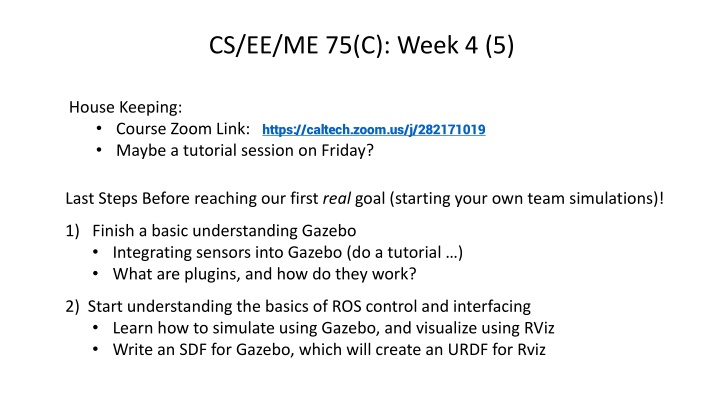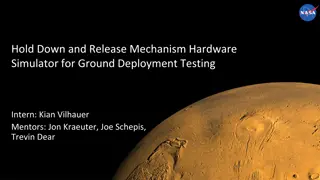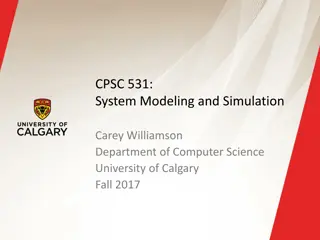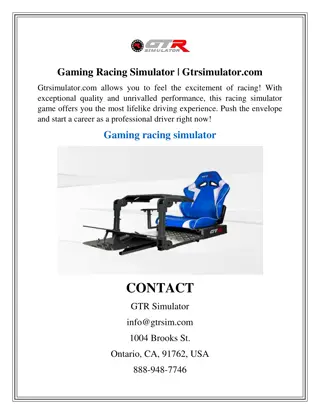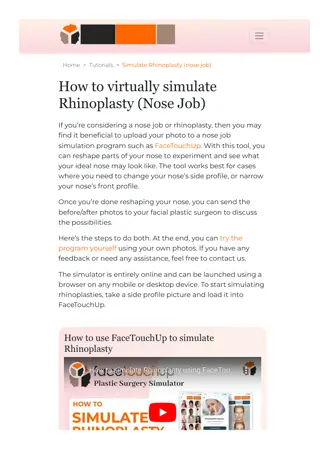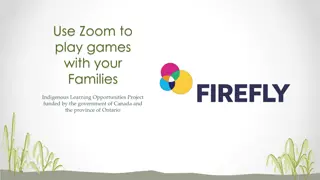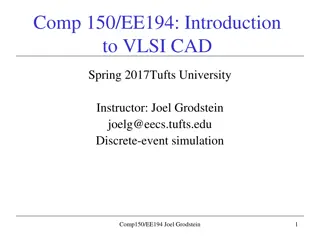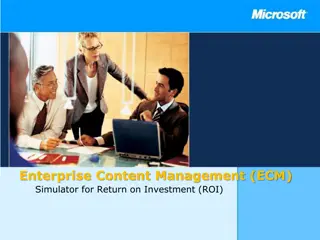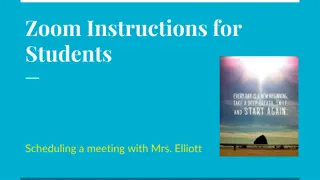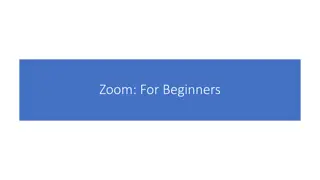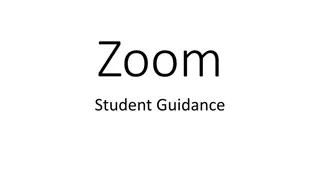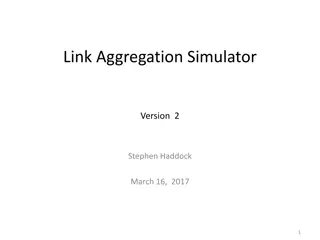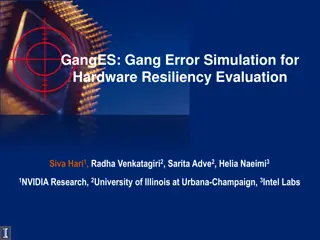House Keeping: Course Zoom Link & Simulator Simulation Basics
The content focuses on exploring Gazebo simulation architecture, plugins, ROS control, and the workflow for simulating robots in a controlled environment. It covers the significance of simulators in testing, debugging, and parallel development. Learn how to integrate sensors, visualize using RViz, and create URDF for Rviz. Discover the role of plugins in modifying Gazebo worlds and controlling simulated robots through ROS.
Download Presentation

Please find below an Image/Link to download the presentation.
The content on the website is provided AS IS for your information and personal use only. It may not be sold, licensed, or shared on other websites without obtaining consent from the author.If you encounter any issues during the download, it is possible that the publisher has removed the file from their server.
You are allowed to download the files provided on this website for personal or commercial use, subject to the condition that they are used lawfully. All files are the property of their respective owners.
The content on the website is provided AS IS for your information and personal use only. It may not be sold, licensed, or shared on other websites without obtaining consent from the author.
E N D
Presentation Transcript
CS/EE/ME 75(C): Week 4 (5) House Keeping: Course Zoom Link: https://caltech.zoom.us/j/282171019 Maybe a tutorial session on Friday? Last Steps Before reaching our first real goal (starting your own team simulations)! 1) Finish a basic understanding Gazebo Integrating sensors into Gazebo (do a tutorial ) What are plugins, and how do they work? 2) Start understanding the basics of ROS control and interfacing Learn how to simulate using Gazebo, and visualize using RViz Write an SDF for Gazebo, which will create an URDF for Rviz
A simulator can mimic many (but not all) aspects of a real world robot deployment Simulate robot geometry & movements Simulate obstacles, objects in the robot s environment Simulate sensor readings and sensor feedback process Simulate physical interactions between objects Most difficult & sensitive simulation Why use simulation? Debug code before testing it in high-cost-of- failure real world situations Test on hardware which is not available Allow for parallel development across sub-teams Create visualization videos
Gazebo Simulation Architecture Worlds: Contains all simulation elements Robots, Static Objects Sensors, Lights Models: describe the robot Geometry, kinematics of links Appearance collision dynamic parameters (for sim visual appearance Interface information Sensors: locations & sensor type Plugins: allow programmed interaction with simulation elements Gazebo implemented as a simulation server and a GUI client
General Gazebo/ROS Simulation Workflow (updated) Launch a world into Gazebo: The launch starts up the world model in Gazebo, as well as the nodes that will control a real robot. But now they control a simulated robot. The last lecture was about Gazebo s worlds, and how to start them within a simulation. This lecture summarizes how we can define feedback control systems in ROS, and what we must do to allow these closed loop systems to operate in simulation. Plugins: allow interaction between ROS & Gazebo ROS Control
Gazebo Plugins Why a Plugin? We need a way for ROS (or other external programs) to modify the Gazebo simulated worlds Send torques to the simulated robots motors. The physics engine then uses its kinematic/dynamic models to predict how the robot will move under the commands Change lighting conditions or other states/parameters of the simulated world The external programs need a way to access the states of the simulated world and robots Sense the current simulated values of the robot joint variables Get the data streamed from the simulated exteroceptors, such as simulated cameras, lidars, ultrasound, etc. What is a Plugin? Implemented as a shared library Dynamically linked (at load time) to Gazebo and ROS Often invoked during launch. But can be loaded/removed any time.
Plugins (continued) Shared Library Dynamic linking of shared library Conventional Library Compilation Process
Plugins (continued) Types of Plugins Different plugins manage different parts of the simulation framework World plugin: modify world settings E.g., lighting conditions, locations of fixed objects, presence/absence of a robot Model plugin: interact with the model (e.g., send simulated commands) Sensor plugin: interaction with simulated sensors (e.g., camera) System plugin: effect system-level actions, like time/network synch. Visual plugin: change the sim. rendering process (e.g., camera view) GUI plugin: change or interact with how the user interface works Most Important for Us
Plugins (continued) How do we incorporate Plugins? Usually incorporated into appropriate xml file A model plugin will be included in the URDF/SDF file describing that model A sensor plugin will also go in the model file where the sensor is defined A combination of xml statements and the loading of a shared library Xml statements define model/sensor parameters Shared library is the compiled c++/python code Written with knowledge of ROS & Gazebo APIs: http://osrf- distributions.s3.amazonaws.com/gazebo/api/9.0.0/index.html Many existing shared libraries exist Created as a ROS package See: https://github.com/SMARTlab-Purdue/ros-tutorial-gazebo-simulation/wiki/Sec.-4:- Creating-a-light-sensor-plugin for an example
ROS Control Every robot (real or simulated) needs a controller Create a closed loop between sensors and actuators to follow commands from: (1) teleoperation (joystick) or (2) a planner Typically there will be many different closed loop control systems needed control the Usually these controllers are hardware/robot/problem specific Often depend on type of actuator and the goals of the robot s assigned task Many theories Create a closed loop between sensors and actuators to follow commands from: (1) teleoperation (joystick) or (2) a planner CDS 110, CDS 141/241, CDS 242 Typically there will be many different closed loop control systems are needed
ROS Control (continued) ROS comes with some generic controllers Many types of robot joint control approaches are very similar: Most robot manipulators/arms are built with 6 or 7 revolute joints Most mobile robots are drive by wheels PID (proportional-integral-derivative) control is usually quite effective for joints/wheels ROS control allows you to get a system up and running quickly. You can develop high performance hardware specialized controllers later. ROS control documentation: https://wiki.ros.org/ros_control ROS Control, and more generally ROS, wants to abstract the specifics of the hardware. This allows different planners and planning strategies to be interfaced readily with your hardware/simulation. Several generic control layers and standards help achieve this goal: Controllers: the closed loop controllers. See https://github.com/ros-controls/ros_controllers for a list of the different types of controllers that already exist.
Effort controller commands joint torque/force Position controllers servo a specific joint displacement Velocity controllers maintain the actuator s speed Joint trajectory controllers to to follow a particular smooth path in joint space Hardware Interfaces Joint command interface (to send command) Joint State Interface (to help read joint sensor info) Transmission Layer Account for transmission effects Joint Limits Interface
Controller Manager: Loads/unloads controllers Starts/stops/synchronizes controllers Switches controllers Manages controller rate The main node of a ROS control system Subscribes to sensor data Subscribes to messages/plans from higher level planner
Homework: Week (4) 5 Goal 1: learn about Gazebo plugins Main page for Gazebo plugin tutorials/documents: http://gazebosim.org/tutorials?cat=write_plugin Read & complete the plugins 101 tutorial: http://gazebosim.org/tutorials?tut=plugins_hello_world&cat=write_plugin This tutorial is a bit bland, but it is a useful first step. While you may eventually need to use every time of plugin for your team, let s focus on these two key plugin types: Model plugins: http://gazebosim.org/tutorials?tut=plugins_model&cat=write_plugin World plugins: http://gazebosim.org/tutorials?tut=plugins_world&cat=write_plugin Goal 2: Test your new knowledge of plugins: Execute this tutorial: http://gazebosim.org/tutorials?tut=ros_gzplugins . It will give you a flavor of using Gazebo and ROS at the same time. This example uses the rrbot model from last week s exercises
Homework: Week (4) 5 Goal 3: learn about ROS Control Execute this tutorial: http://gazebosim.org/tutorials/?tut=ros_control This tutorial builds upon the previous rrbot tutorials If you haven t visited the site already, you may want to skim over the ROS Control documentation page: http://wiki.ros.org/ros_control Also note the GitHub wiki on ros control: https://github.com/ros-controls/ros_control/wiki It has notes and pointers on building/implementing new controllers
